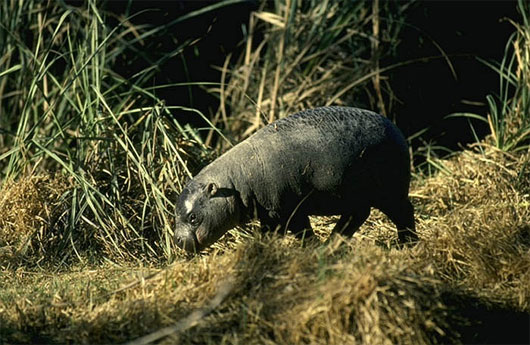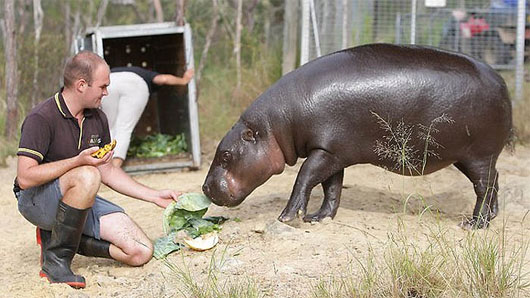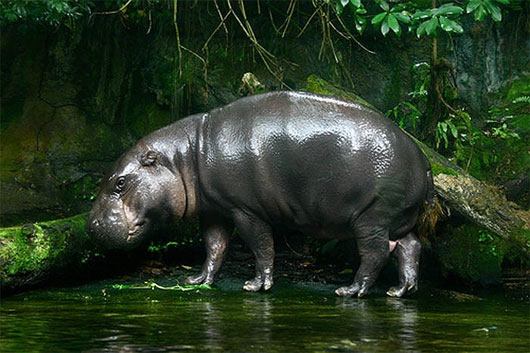Tiny hippopotamus, a mysterious little-known animal
Hippopotami dae, is a mammal herbivore of about 5kg at birth and 150kg when mature, only 1/10 of the weight of a hippopotamus relative. Previously, dwarf hippos were present in all European countries, but are now only found in the swamps and mangrove forests of sub-Saharan Africa.
Dwarf hippopotamus are in danger of extinction, at an extremely dangerous level. They are at risk of losing to human slaughter and change of habitat. It is estimated that only about 3000 individuals exist worldwide.

Different from the fierce, fierce appearance of giant hippos, dwarf hippos are meek, shy and incredibly adorable animals. This animal has a very special habitat, they live half underwater, half terrestrial and are a skilled "swimmer" because of their ability to swim and dive deep in the water.
The dive time of these "fishers " is up to 5 minutes. They are 4-legged animals that are in the habit of "going out, dive to the sun and roast the sun" . One day they spend up to 16 hours to swim, dive, immerse themselves in water and mud.

They are deep in the water and only show the head part, leaving eyes and nose to observe and breathe. The eyes are dim, dreamy and full of satisfaction, enjoying the coolness of the water. This species has a very special way of cooling the body. Many people are shocked to see "fresh blood" drenched on the head and back of hippos in a feeding area.

They accused the authorities and staff of taking care of them because they thought they were badly treated by the people here. But that's just a suspension that acts as an antibiotic-rich sunscreen to cool and protect the body. The red liquid is like a "cosmetic", which helps the hippopotamus to look pink and beautiful.
The new sunset is the time when they start "working" to feed themselves. The grass and the fruit are the food they like. The female hippo begins to give birth when she reaches the age of 5 - 6. The gestation period is also quite long, almost equal to the pregnancy time of 8 months.

Dwarf hippos also have extremely special "cap" systems on their nostrils, eyes and ears. These caps will automatically close when entering the water, to prevent water from getting inside. With these "caps," the hippopotamus can be breastfed at any time if it wants to be shallow or underwater.
Recently, officials and zoo staff of Blijdorp, Rotterdam in South Africa were extremely happy to welcome a dwarf hippopotamus born. The zoo director shared that this is the first dwarf hippopotamus born here during the past 23 years.
- Hippopotamus mother risked her life to save me
- 'The champion' lives the longest herbivore dies
- Hippopotamus rushed out of the water to grab a helicopter
- What effect does hippopotamus skin have?
- The turtles are crowded on the hippopotamus' back
- Hippo's milk is pink and this is the reason
- Israeli Hippo has just spawned in Dai Nam Tourist Area
- Hippopotamus attacked wild buffalo to monopolize the puddle
- Crocodile fight hippopotamus: who is the hegemon of African rivers?
- Animal photos last week: Dogs give owners water to drink
- Tiny water bug: the most
- More than 100 dead hippos are suspected of being anthrax in Namibia
 Animal 'suffering' after hibernation
Animal 'suffering' after hibernation Why do goats climb well?
Why do goats climb well? Scientists were surprised to see chimpanzees eating turtles
Scientists were surprised to see chimpanzees eating turtles Giant catfish died deadly due to drought in Thailand
Giant catfish died deadly due to drought in Thailand The turtles are crowded on the hippopotamus' back
The turtles are crowded on the hippopotamus' back  Found the ancient hippo fossil named
Found the ancient hippo fossil named  Being chased by hippopotamus, the tailed lion loses the lord of the lord
Being chased by hippopotamus, the tailed lion loses the lord of the lord  Hippopotamus rushed out of the water to grab a helicopter
Hippopotamus rushed out of the water to grab a helicopter  Hippopotamus attacked wild buffalo to monopolize the puddle
Hippopotamus attacked wild buffalo to monopolize the puddle  At the ban of hippopotamus, crocodiles are beaten
At the ban of hippopotamus, crocodiles are beaten 